Abbiamo intervistato uno dei DJ e produttori italiani più famosi del panorama elettronico mondiale, Sam Paganini, in occasione dell’uscita del suo ultimo EP “Body Ride / Demon”, e non ha risparmiato risposte affilate alle nostre domande.
Sam Paganini, classe 1972, è cresciuto nella città italiana di Vittorio Veneto, in provincia di Treviso. Ha il carattere deciso e diretto delle persone del nord ma non è un tipo schivo, anzi, risponde in modo alquanto tranquillo, puntuale e con sentimento alle nostre domande, le più scomode. Anche quelle inerenti alla politica.
“Trovo tutta la situazione vergognosa, come lo è tutta la politica Italiana. […]”
Sam Paganini

È sicuramente un artista che si è costruito da solo, passando tutte le fasi della formazione. Veniva da una famiglia e da un luogo umili, in un tempo in cui non c’erano ancora molte tecnologie che accorciavano le distanze, e dove non c’erano neanche tante possibilità di evadere, se non con la musica. Ma che comunque dovevi andare a cercare e scovare. Magari prendendo un pullman per arrivare al negozio di dischi più vicino.
Sam, all’età di quindici anni, suonava batteria, chitarra e pianoforte in vari gruppi rock locali. Già sapeva, però, che avrebbe dedicato la sua vita all’elettronica.
“Nottate su nottate nei club e concerti seduto alla batteria dei vari gruppi rock in cui ho militato girando il nord Italia.”
Sam Paganini
La folgorazione, infatti, avvenne intorno ai tredici anni quando la curiosità lo spinse a entrare in un locale ancora vuoto, sotto un ristorante, dove c’era il DJ resident che provava i nuovi dischi da proporre. Cominciò a fantasticare su cosa potesse accadere in quel posto durante le serate, e quella sensazione se l’è portata dietro per tutta la vita.
L’anno fondamentale, comunque, fu il 1996. Anno del successo mondiale di uno dei suoi primi brani, “Zoe” prodotto come Paganini Traxx. Ciononostante, non era ancora il momento della vera svolta e, per diversi anni, Sam Paganini è stato rappresentato da varie etichette minori fino a quando, finalmente, nel 2011, il pioniere della techno Richie Hawtin lo portò sulla sua Plus 8, con l’EP “Cobra”.
Da lì un continuo crescendo, con le successive uscite su label come Cocoon Recordings e Drumcode. Tanto che, nel 2014, su quest’ultima rilasciò LP “Satellite” che conteneva un brano diventato subito un classico della techno, “Rave”, una traccia iconica, senza tempo.
Poi nel 2016 arrivò anche la sua etichetta discografica, la JAM. Una nuova piattaforma per riprodurre la sua visione della musica elettroncia e per scoprire nuovi talenti. Stessa label sulla quale sta uscendo (il 26 maggio 2023 su Beatport e Spotify, il 9 giungo sugli altri store) anche il suo ultimo progetto “Body Ride / Demon EP”.
La sua musica e i suoi set sono stati descritti come “Sexy Groovy Dark Techno”, il che la dice lunga, letteralmente, su cosa aspettarsi dalle sue esibizioni, nelle quali riesce a equilibrare le sue due anime, quella più underground e quella più mainstream.
“Solitamente mi arriva più facilmente un idea mente faccio del sound design alla ricerca di qualche nuovo suono su una macchina hardware piuttosto che su un plug in.”
Sam Paganini
Inutile dire che ha calcato il palco dei migliori festival e dei club leggendari, dal Berghain al Cocoricò, dal KAPPA Future Festival al Tomorrowland, passando per il Monegros, il Time Warp, il Sonus, il Pacha, l’Amnesia, il Rex, il Fuse di Bruxelles e il Fabric di Londra.
Ma adesso è arrivato il momento di far parlare Sam, una chiacchierata piacevole e ricca di spunti.
Ciao Sam! È un piacere averti su Parkett. Sei uno dei DJ più conosciuti del mondo. Alcune tue tracce sono iconiche, hanno fatto storia. Ma dove e quando è cominciato il tuo fantastico viaggio?
Piacere mio, ragazzi!
Piccolissimo, all’età di 4/5 anni avevo già manifestato predisposizione per uno strumento come la batteria. I miei genitori si sono accorti ben presto della mia ossessione per la musica in generale. Ho passato l’adolescenza in salotto, dopo la scuola, ad ascoltare musica in cuffia sull’hi-fi Pioneer che fortunatamente mio padre, con un bel po’ di sacrificio, riuscì a comperarsi.
Radio Italia Network negli anni ’80 trasmetteva, 24 ore su 24, musica dance con interventi pubblicitari minimi e senza nessun DJ a blaterale a vanvera cose di cui non me ne sarebbe interessato nulla. Mi aprì le porte e la mente a un infinità di nuovi dischi. Cominciai a farmi le mie prime compilation su cassetta.
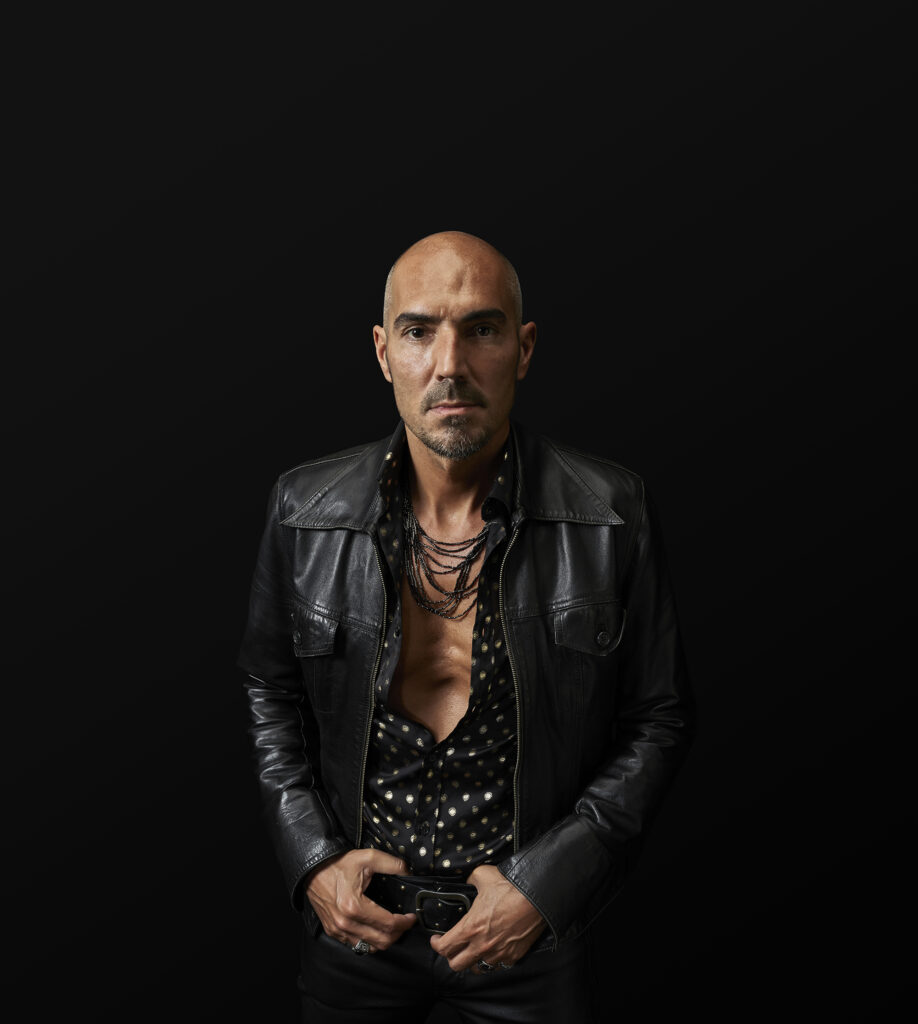
Nello stesso periodo mia mamma lavorava come cameriera in un ristorante al Lago Di Santa Croce, in provincia di Belluno, dove vivevamo. Sotto al ristorante esisteva un piccolo night club e spesso sentivo il DJ resident che provava i dischi appena comprati e che avrebbe proposto alla clientela in serata.
Ovviamente morivo dalla voglia di poter vedere cosa stesse facendo e finalmente un giorno ebbi il permesso di scendere con lui nel locale. Avevo 13 anni e l’emozione che provai entrando in quel posto, completamente vuoto, è ancora viva nella mia mente.
La moquette impregnata dall’odore del fumo durante le nottate di baldoria, la piccola cabina del DJ, l’unico bar con tutte le bottiglie di superalcolici esposti, le poltroncine e i divanetti in velluto nelle varie zone buie del locale fecero viaggiare la mia fantasia. Immaginavo cosa succedesse durante le notti in quel club, cose proibite e segrete. Ascoltando quella musica pazzesca uscire dalle casse e immaginando che tipo di sensazione potesse provare il DJ nel proporla durante i party notturni. Capii all’istante che avrei dato tutto me stesso per intraprendere questa strada.
Nel giro di poco tempo riuscii a fare il light Jay, le domeniche pomeriggio, in un locale della mia zona, e poco più che quindicenne feci la mia prima performance pomeridiana per sostituire il DJ resident che quel giorno non era potuto arrivare. In breve tempo arrivarono gli ingaggi per le prime stagioni in club del Triveneto. Studiai un paio di anni di pianoforte e mi appassionai anche alla chitarra.
Compresi il potenziale dei nuovi sequencer come Cubase e la computer music, cioè poter registrare uno strumento alla volta in totale solitudine senza l’ausilio di una band.
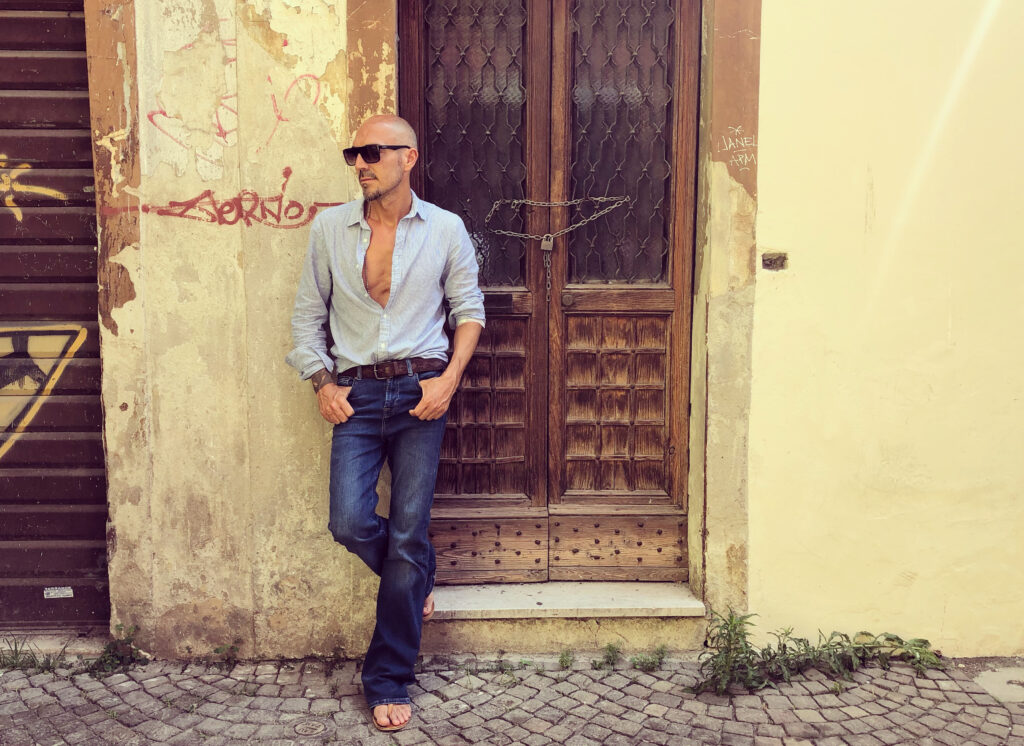
Nel 1993 mandai i miei primi rudimentali demo a Gianfranco Bortolotti della Media Records, che all’epoca era un etichetta di grande peso nel panorama dance mondiale, e mi propose di spostarmi a Brescia per lavorare in uno dei leggendari studi dell’etichetta.
Così feci. Nel giro di un anno imparai molto su tecniche di produzione e sull’arrangiamento di brani dance, ma poi arrivò il momento di costruirmi un mio studio personale dove lavorare da solo, in totale autonomia, e poter esprimermi in una direzione musicale meno commerciale e più vicina al mio sound da DJ.
Nel 1996 la mia prima hit “Zoe” come Paganini Traxx, ma sfortunatamente non era ancora il momento per una carriera internazionale. Quindi nottate su nottate nei club e concerti seduto alla batteria dei vari gruppi rock in cui ho militato girando il nord Italia. Periodi anche molto difficili, fino a quando finalmente a fine decennio del nuovo millennio la mia carriera internazionale è decollata e mi ha portato dove sono oggi.
Una lunga storia. A proposito di tracce iconiche, “Rave” sicuramente è uno dei tuoi brani più famosi. Dicono i numeri, la più cliccata traccia techno della storia. Ma che rapporto hai tu con questo brano?
Mi spiego: penso che quando vai ad un evento le persone quasi si aspettano che la suoni. Ma come lo vivi invece tu quel momento?
Non sono quel tipo snob di artista che si rifiuta categoricamente di suonarla perché stremato dalle richieste. Ne sono onorato quando me la chiedono e nutro sempre rispetto per il pubblico.
Una cosa, però, che il pubblico non sempre tiene presente, è che ci sono fan che mi seguono da molti anni e che fanno regolarmente serate in mia compagnia. Sono passati 9 anni dall’uscita di quel disco e c’è anche chi non ne può più di sentirla.
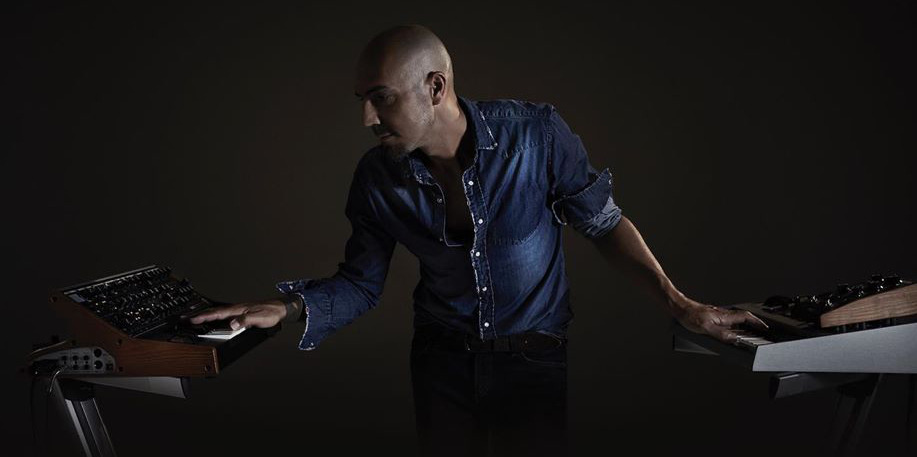
Avendo aggiunto lo spettacolo LIVE alle mie performance, in cui non faccio il DJ ma suono solo ed esclusivamente la mia musica e le mie tracce più conosciute, è chiaro che “Rave” deve essere in scaletta. È il suo giusto contesto e, ora come ora, metterla semplicemente come DJ non mi entusiasma. Quindi, oggi, capita in rarissime occasioni suonando, appunto, come disc jockey.
Se uno dei brani più famosi che hai composto si chiama “Rave” non posso non chiederti cosa ne pensi riguardo tutta la vicenda che si è venuta a creare di recente e che ha portato a un decreto anti-rave.
Trovo tutta la situazione vergognosa, come lo è tutta la politica Italiana.
Ho sentito recentemente dire alla Meloni che con questa legge voleva mandare un segnale. Questa gente pensa che sia più importante fermare un paio di eventi all’anno, in cui qualche centinaio di ragazzi si accampa in un posto che non è di sua proprietà, ma abbandonato, e porta un impianto per ballare, piuttosto che lanciare un segnale, ad esempio, a quei delinquenti che occupano casa di un anziano. Il quale è stato assente, perché ricoverato in ospedale, e al suo rientro si trova la serratura cambiata. Senza che possa fare nulla per riprendersi casa propria. Follia.
Due settimane c’hanno messo a fare la legge anti-rave.
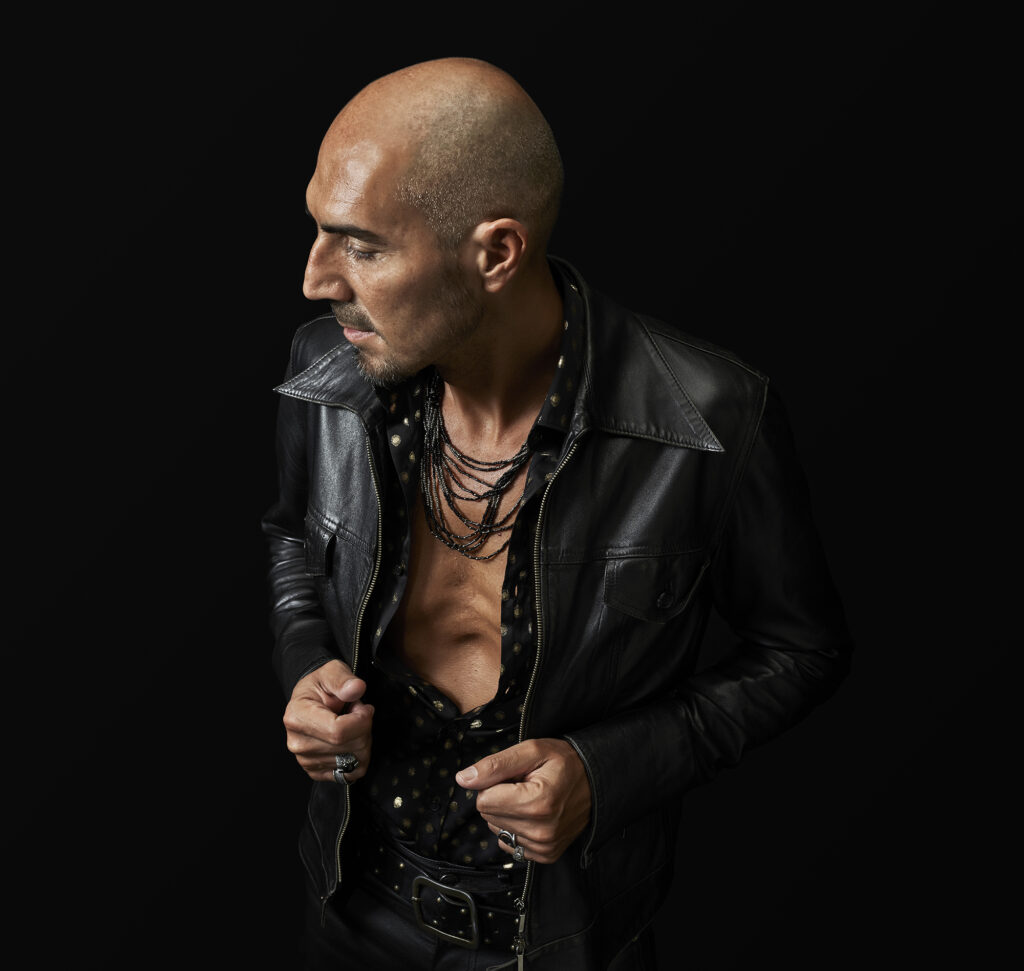
O vogliamo parlare degli Ultras del calcio? Che bloccano una autostrada e devastano intere città? Non dico che i raver possano fare quello che vogliono, ma di certo ci sarebbero ben altre cose da sistemare in Italia e su cui “lanciare segnali”.
Parole chiare. Ultimamente ti eri anche un po’ allontanato, per così dire, dalla pista da ballo, spiazzando, ma ricevendo anche molti complimenti da critica e pubblico. Mi riferisco all’ album “Reflections” e a parte di “Light + Shadow”. Come mai avevi fatto quell’ inversione di rotta verso musica più da ascolto?
Quando è arrivata la pandemia ho avuto improvvisamente tempo per lavorare in studio. Stare sui social pubblicando cose inutili e fuori luogo, o fare DJ live stream dal soggiorno di casa non è mai stata una opzione per me.
Non trovavo nemmeno un senso a pubblicare techno in un momento in cui non c’era nessuno che potesse sentirla a un volume adeguato in un club o ad un festival. “Reflections” è un side project, il titolo completo è Sam Paganini Presents “Reflections”. Nel corso degli anni ho registrato diverse demo di musica da ascolto. Un paio di queste, “Far Away” e “Fallen”, le ho potute finire quando è partita la pandemia.
Ho sfruttato il lockdown per concretizzare altre idee che avevo in testa e che non avevo ancora potuto registrare perché costantemente in tour in giro per il mondo. Lavorare senza nessuna distrazione giorno e notte in studio è stato fantastico, in un paio di mesi l’album era pronto.
Con tutti i club del mondo chiusi a causa della pandemia ho deciso di pubblicarlo e ovviamente il pubblico si è diviso, ne ero preparato. Ho ricevuto molti elogi da nuovi fan, che probabilmente nemmeno vanno a ballare, ma anche critiche da chi è solamente abituato alla musica dance e si aspetta a ogni mia nuova uscita un’altra “Rave”.
Adesso, invece, stai tornando prepotentemente con ” Body Ride / Demon” EP. Ci puoi spiegare un po’ l’anima di questo nuovo progetto?
Dal mio punto di vista è un grande vantaggio poter testare un nuovo demo appena registrato in studio e vedere che feedback riceve dalla pista da ballo. Cosa che, infatti, mi è mancata nella composizione dell’ultimo album “Light+Shadow”.

Le tracce dance non hanno potuto avere il test del dancefloor e, dal momento che l’album è stato pubblicato quando ero ancora fermo (e sopratutto pignolo come sono), dopo averle potute finalmente testare avrei voluto cambiare molti arrangiamenti.
Ora che ci siamo lasciati alle spalle la pandemia e ho ripreso i tour ho molti più stimoli e idee. Un paio di queste hanno superato molto bene il test del dancefloor e ho deciso di ultimarle e pubblicarle. Sono due tracce diverse tra loro, “Body Ride” ha un feeling old school ipnotico, che non lascia tregua. “Demon” invece suona più attuale e ha una componente più melodica.
Cambiando argomento. I nostri lettori sono molto curiosi di sapere qual è, invece, il tuo set up in studio. C’è anche qualche strumento a cui sei affezionato, magari che non usi più, ma che hai sempre lì al tuo fianco?
Ho un set up piuttosto comune: uso Cubase o Ableton Live come sequencer, una sound card Universal Audio a 16 canali che confluiscono in un sommatore Dangerous e finiscono su un compressor/limiter DBX.
Sono un collezionista di vecchi synth e amo le vecchie macchine analogiche. In prima posizione un Minimoog degli anni ’70 acquistato a Londra nel 2002, e poi, per citarne alcuni, un Prophet5, Jupiter 8, Juno106, Juno2, Korg MS20, TB303, Fender Rhodes e tra i più recenti il Moog Voyager e il Moog One.
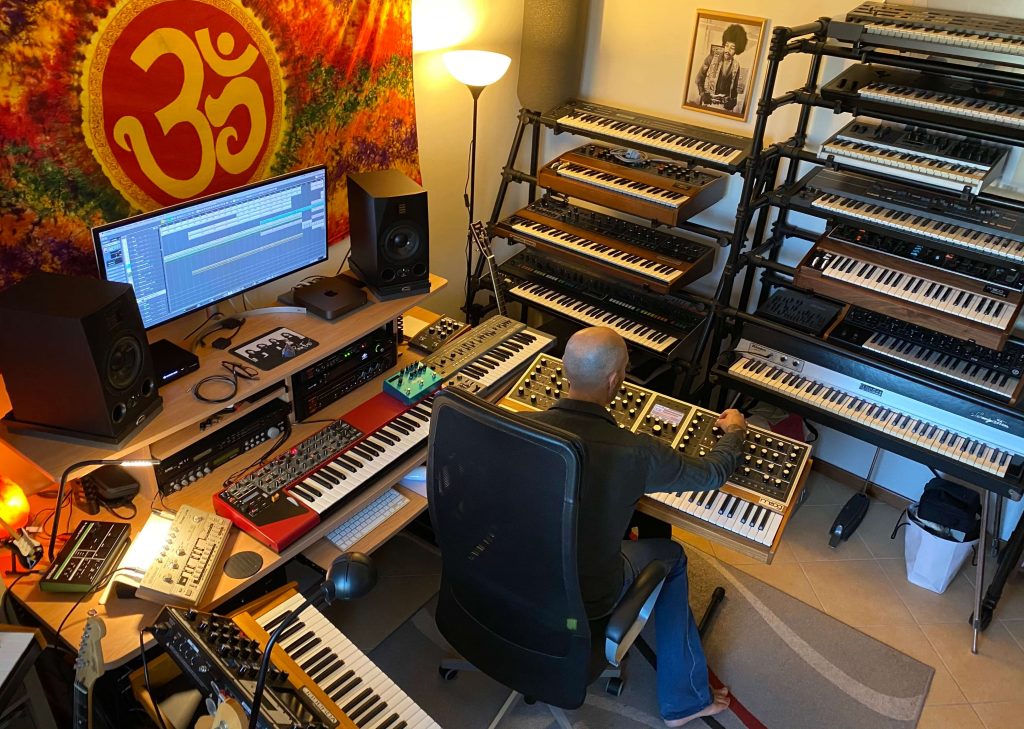
Solitamente mi arriva più facilmente un’idea mentre faccio del sound design alla ricerca di qualche nuovo suono su una macchina hardware piuttosto che su un plug in. È comunque capitato di aver sfruttato un preset di una replica plug in e poi averlo ricreato sull’originale hardware, per avere un suono molto più incisivo.
Una mia curiosità invece è che diversi DJ e produttori di musica elettronica, anche giovani, per lo più techno, spesso mi dicono che ascoltano, o ascoltavano, molto metal o hard-rock. So che per te è lo stesso. Ce lo sai spiegare il perché?
Perché fondamentalmente l’atmosfera e l’energia che si crea in un dancefloor con della techno è simile a quella che hai ad un concerto Hard Rock o Metal.
Vedere migliaia di persone con le braccia alzate e sentire un boato a ogni ripartenza a un festival techno è qualcosa di molto potente ed emozionante.
A tal proposito, prima di salutarci, vorrei chiederti una classifica dei 4/5 gruppi/cantanti, non propriamente elettronici, che ti hanno influenzato maggiormente.
Pink Floyd in primis, poi moltissimi altri, direi Rockets, Led Zeppelin, Rolling Stones, Depeche Mode e Duran Duran.
Eccoci arrivati alla fine, purtoppo. E come al solito nelle mie interviste lascio uno spazio libero in cui puoi condividere con noi un tuo pensiero o un’istanza che hai a cuore. Intanto io ti saluto e ti ringrazio. Ciao Sam!
Credo sinceramente di essere una persona molto fortunata. Riuscire a realizzare il proprio sogno è un vero privilegio, ma la chiave è non mollare mai, e cercare di essere il più obiettivo possibile. Se la tua passione sarà più forte delle inevitabili batoste e sconfitte prima o poi arriverà la grande occasione.
È stato un piacere parlare con voi!
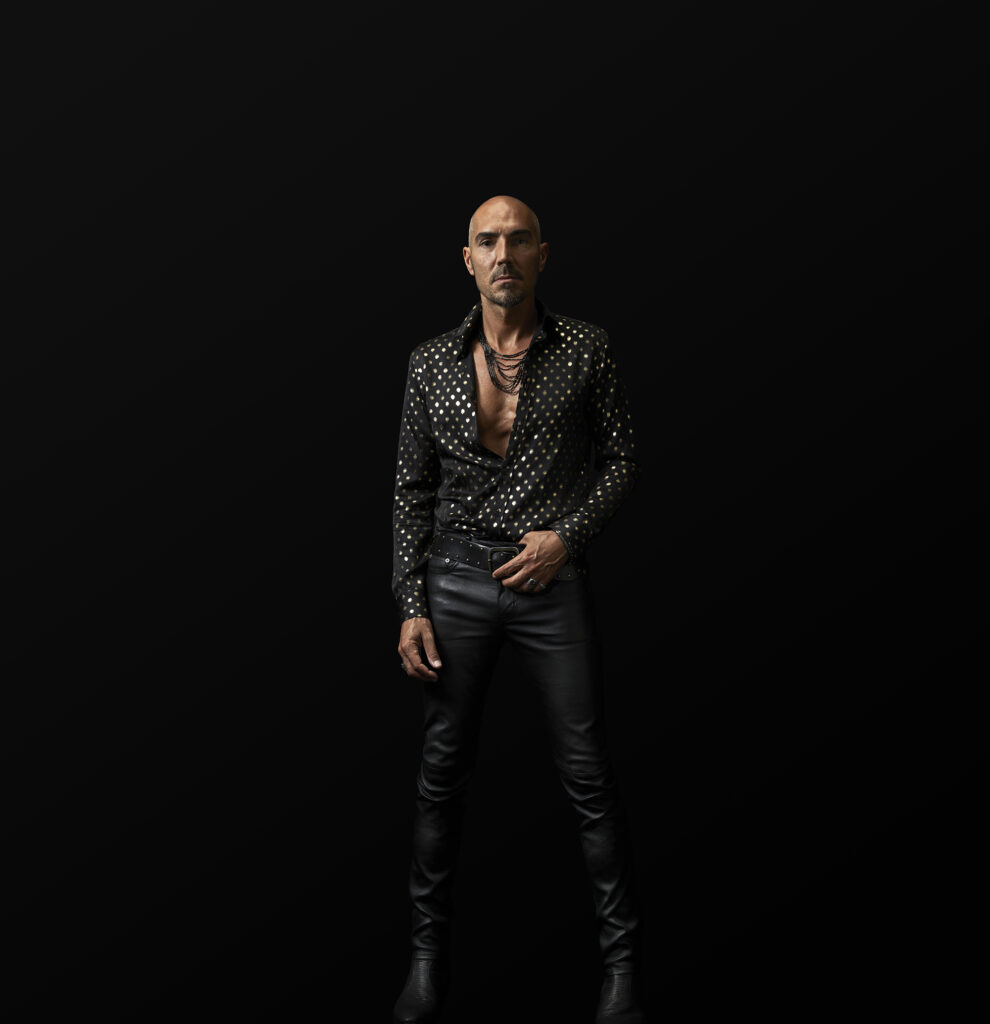
Info, Sam Paganini – Body Ride / Demon EP
Tracklist:
1) Body Ride
2) Demon
Artista: Sam Paganini
Titolo: Body Ride / Demon
Label: JAM
Num.Cat: JAM050
Data Release: 26 maggio 2023 (Beatport e Spotify), il 9 giungo 2023 (altri store)
L’EP segna la release numero 50 della JAM.
ENGLISH VERSION
Ciao Sam! It’s a pleasure to have you on Parkett. You are one of the best known DJs in the world. Some of your tracks are iconic, they made history. But where and when did your fantastic journey begin?
My pleasure guys!
Very small, at the age of 4/5 I had already shown a predisposition for an instrument such as the drums. My parents soon became aware of my obsession with music in general. I spent my adolescence in the living room, after school, listening to music through headphones on the Pioneer hi-fi which fortunately my father, with a lot of sacrifice, was able to buy.
Radio Italia Network in the ’80s broadcast dance music 24 hours a day with minimal advertising interventions and without any DJ blathering at random, things I wouldn’t have cared about at all. It opened the doors and my mind to an infinite number of new records. I started making my first cassette compilations.
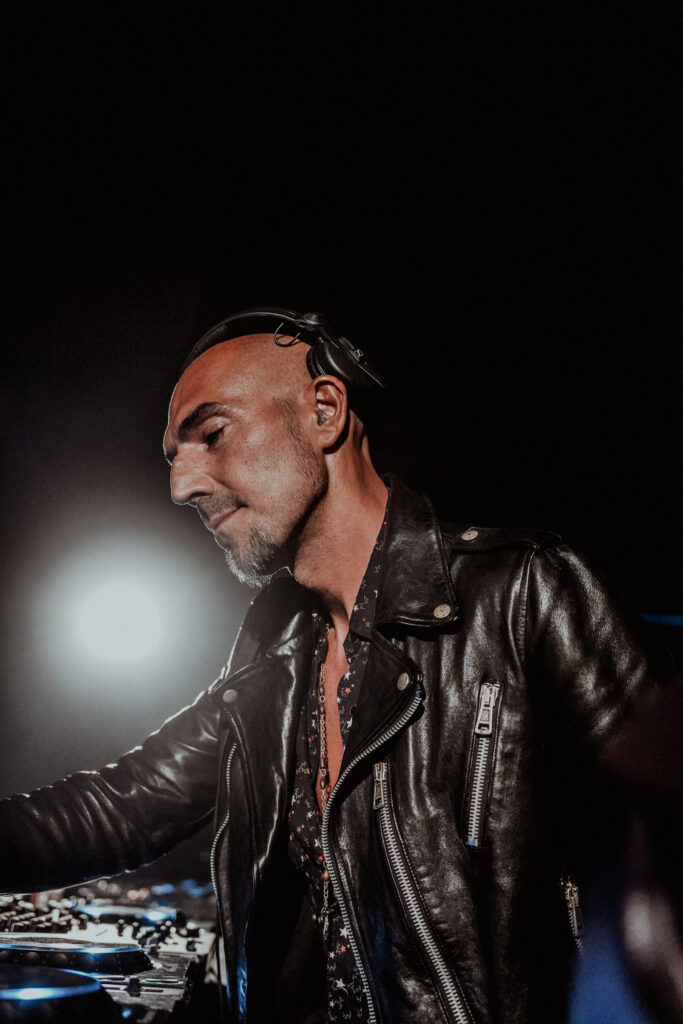
At the same time my mother worked as a waitress in a restaurant at Lago Di Santa Croce, in the province of Belluno, where we lived. Below the restaurant there was a small night club and I often heard the resident DJ trying out the records he had just bought and which he would offer to customers in the evening.
Obviously I was dying to be able to see what he was doing and finally one day I was allowed to go down with him to the club. I was 13 and the emotion I felt entering that completely empty place is still alive in my mind.
The carpet impregnated with the smell of smoke during the nights of revelry, the small DJ booth, the only bar with all the bottles of spirits on display, the velvet armchairs and sofas in the various dark areas of the club let my imagination travel. I imagined what happened during nights in that club, forbidden and secret things. Listening to that crazy music coming out of the speakers and imagining what kind of feeling the DJ could feel when proposing it during the night parties. I knew instantly that I would give my all to take this path.
Within a short time I was able to play light Jay on Sunday afternoons in a club in my area, and when I was just 15 I had my first afternoon performance to replace the resident DJ who hadn’t been able to arrive that day. In a short time the engagements for the first seasons in Triveneto clubs arrived. I studied piano for a couple of years and also became passionate about the guitar. Including the potential of new sequencers such as Cubase and computer music, that is, being able to record one instrument at a time in total solitude without the help of a band.
In 1993 I sent my first rudimentary demos to Gianfranco Bortolotti of Media Records, which at the time was a very important label in the world dance scene, and he asked me to move to Brescia to work in one of the label’s legendary studios.
So I did. Within a year I learned a lot about production techniques and the arrangement of dance tracks, but then the time came to build my own studio where I could work alone, in total autonomy, and be able to express myself in a less commercial and more close to my DJ sound.
In 1996 my first Hit “Zoe” as Paganini Traxx, but unfortunately it was not yet time for an international career. So night after night in clubs and concerts sitting on the drums of the various rock bands in which I played around northern Italy. Even very difficult periods, until finally, at the end of the new millennium, my international career took off and brought me to where I am today.
A long story. Speaking of iconic tracks, “Rave” is definitely one of your most famous songs. The numbers say, the most clicked techno track in history. But what relationship do you have with this song?
Let me explain: I think when you go to an event people almost expect you to play it. But how do you live that moment instead?
I’m not that snob type of artist who categorically refuses to play it because they are exhausted by requests. I am honored when asked and I always have respect for the public.
One thing, however, that the public doesn’t always keep in mind is that there are fans who have been following me for many years and who regularly have evenings with me. 9 years have passed since the release of that record and there are also those who are fed up with hearing it.
Having added the LIVE show to my performances, where I don’t DJ but only play my music and my best known tracks, it is clear that “Rave” must be in the lineup. That’s her context, and right now, just putting her as a DJ doesn’t excite me. So, today, it happens on very rare occasions playing, in fact, as a disc jockey.
If one of the most famous songs you’ve composed is called “Rave” I can’t help but ask you what you think about the whole story that has recently arisen and which has led to an anti-rave decree.
I find the whole situation shameful, as is all Italian politics.

I recently heard Meloni say that with this law she wanted to send a signal. These people think it’s more important to stop a couple of events a year, where a few hundred kids camp out in a place they don’t own, but abandoned, and bring a music system to dance, rather than send out a signal, for example, to those delinquents who occupy the house of an elderly person. Who was absent because he was hospitalized, and when he returns, the lock is changed. Without him being able to do anything to take back his own home. Folly.
It took them two weeks to draft the anti-rave law.
Or do we want to talk about the Ultras of football? Who block a highway and devastate entire cities? I’m not saying that ravers can do what they want, but certainly there would be many other things to fix in Italy and about which to “launch signals”.
Clear words. Lately you had also moved away a little, so to speak, from the dance floor, surprising, but also receiving many compliments from critics and the public. I’m referring to the album “Reflections” and part of “Light + Shadow”. Why did you make that turnaround towards more listening music?
When the pandemic hit I suddenly had time to work in the studio. Being on social media posting useless and inappropriate things, or DJing live streams from the living room at home has never been an option for me.
I also didn’t see the sense in releasing techno at a time when there was no one who could hear it at a suitable volume in a club or at a festival. “Reflections” is a side project, full title is Sam Paganini Presents “Reflections”. Over the years I have recorded several demos of listening music. A couple of these, “Far Away” and “Fallen”, I was able to finish when the pandemic started.
I used the lockdown to realize other ideas that I had in mind and that I hadn’t been able to record yet because I was constantly on tour around the world. Working without any distractions day and night in the studio was fantastic, in a couple of months the album was ready.
With all the clubs in the world closed due to the pandemic I decided to release it and obviously the audience was divided, I was prepared for it. I received a lot of praise from new fans, who probably don’t even go dancing, but also criticism from those who are just used to dance music and expect another “Rave” with every new release of mine.
Now, however, you’re making a comeback with the “Body Ride / Demon” EP. Can you explain a bit about the soul of this new project?
From my point of view it is a great advantage to be able to test a new demo just recorded in the studio and see what feedback it gets from the dance floor. Which, in fact, I missed in the composition of the last album “Light + Shadow”.
The dance tracks could not have the dancefloor test and, since the album was released when I was still at a standstill (and especially fussy as I am), after finally being able to test them I wanted to change many arrangements.
Now that we have left the pandemic behind and I have resumed touring I have a lot more inspiration and ideas. A couple of these passed the dancefloor test very well and I decided to finalize and publish them. They are two different tracks, “Body Ride” has a hypnotic old school feeling , which leaves no respite. “Demon” instead sounds more current and has a more melodic component.
Changing topic. Our readers are very curious to know what your studio set up is. Is there also some tool that you are fond of, perhaps that you no longer use, but that you always have there by your side?
I have a pretty common setup: I use Cubase or Ableton Live as a sequencer, a 16-channel Universal Audio sound card that feeds into a Dangerous adder and ends up with a DBX compressor/limiter.
I am a collector of old synths and I love old analog machines. In first position a Minimoog from the 70s purchased in London in 2002, and then, to name a few, a Prophet5, Jupiter 8, Juno106, Juno2, Korg MS20, TB303, Fender Rhodes and among the most recent the Moog Voyager and the Moog One.
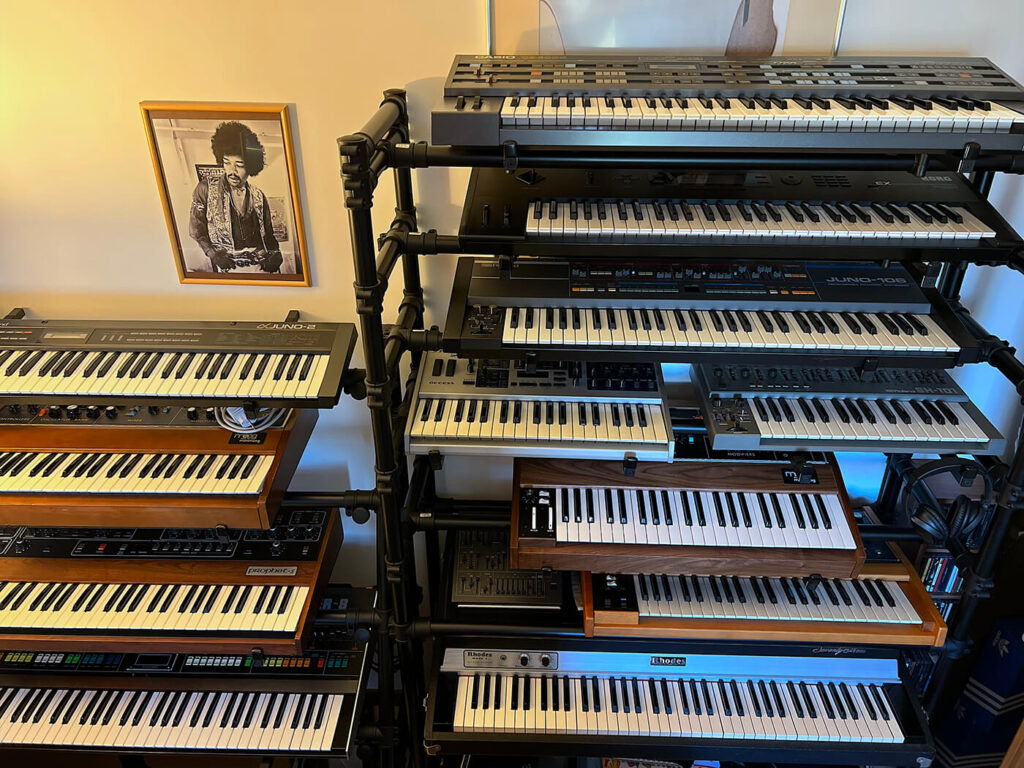
Usually I get an idea more easily while I’m doing sound design looking for some new sound on a hardware machine rather than on a plug in. However, it happened to have used a preset of a plug-in replica and then recreated it on the original hardware, to have a much more incisive sound.
A curiosity of mine however is that several DJs and electronic music producers, even young ones, mostly techno, often tell me that they listen, or used to listen, to a lot of metal or hard-rock. I know it’s the same for you. Can you explain to you and to us why?
Because basically the atmosphere and energy that is created in a dancefloor with techno is similar to what you have at a Hard Rock or Metal concert.
Seeing thousands of people with their arms raised and hearing a roar with every restart at a techno festival is something very powerful and exciting.
In this regard, before saying goodbye, I would like to ask you for a ranking of the 4/5 groups/singers, not exactly electronic, who have influenced you the most.
Pink Floyd first, then many others, I would say Rockets, Led Zeppelin, Rolling Stones, Depeche Mode and Duran Duran.
Here we are at the end, unfortunately. And as usual in my interviews, I leave you a free space where you can share with us your thoughts or a request that you hold dear. In the meantime, I greet you and thank you. Bye Sam!
I sincerely believe that I am a very lucky person. Being able to make your dream come true is a real privilege, but the key is to never give up and try to be as objective as possible. If your passion is stronger than the inevitable beatings and defeats, sooner or later the big opportunity will come.
It was a pleasure talking to you!
